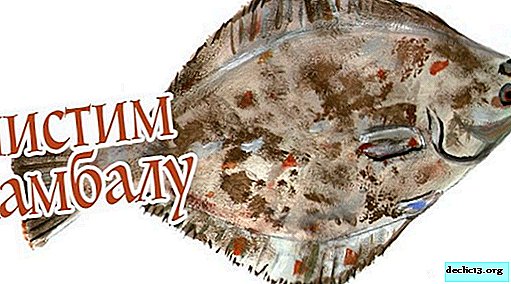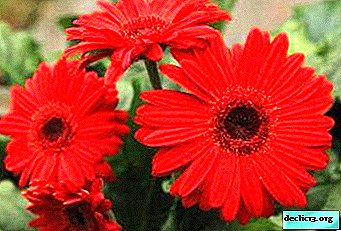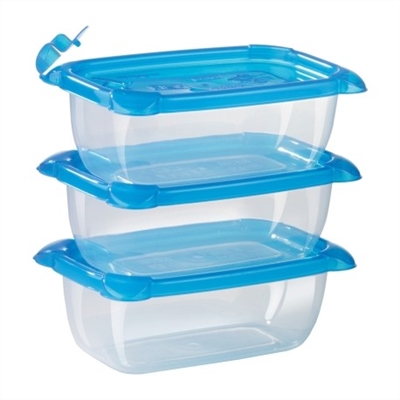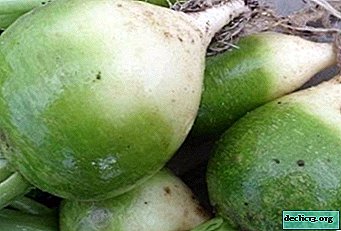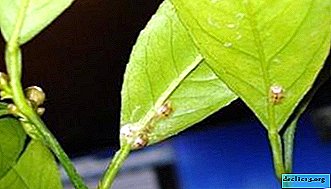Original border roses spray. Photo and description of varieties, features of cultivation
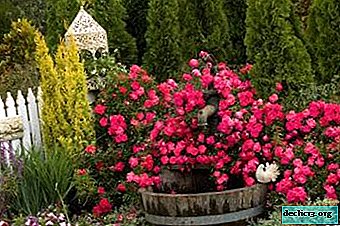
Any rose is the queen of flowers in the garden. Having even a small garden, everyone strives to highlight the best place for this flower. Recently, among many groups, rose spray is gaining popularity.
They are loved by flower growers, landscape designers and florists for lush inflorescences and charming modesty.
This article describes in detail the original border rose spray. A photo and description of the varieties, especially cultivation, are presented.
What it is?
Rose spray is a group of undersized border roses. Literally, the name of the group translates as “pink spray” due to the numerous flowers abundantly covering the entire bush. These roses were singled out in a separate group at the end of the 20th century from the floribunda group. They retained the best qualities of floribund, differing from the latter in smaller flowers, an abundance of flowers on a branch and long flowering throughout the summer.
In terms of habit, these small-flowered roses are compact bushes, 50-70 cm high. The shoots have almost no thorns. Small flowers, ranging in size from 3-6 cm, are collected in inflorescences of 13-18 pieces. The buds at the beginning of flowering have the shape of a glass, which, when completely dissolved, turn into a cup.
Breeders bred many varieties with different shapes, sizes and colors of the flower. In the spray group's color palette there are varieties with white, pink, red, orange, yellow flowers and their shades. Varieties with bicolor flowers are interesting.Distinctive features of the species
- A small number of thorns on the stems or their complete absence.
- Continuous flowering throughout the season.
- Each individual flower does not fade for a long time after dissolution.
- Undemanding care.
- Hardy to adverse weather factors - heat, drought, frost.
- Suitable for cultivation in central Russia, certain varieties can be grown in regions with harsh climates.
- Flowers retain freshness for a long time in cut.
- They are widely used in park and garden landscape design.
Popular varieties - names, descriptions and photos
Lydia

A compact bush (60-70 cm) is strewn with numerous soft pink flowers that change tone, depending on the lighting. Flowering is plentiful, continuous throughout the summer. Resistant to cold. Rose Lydia is perfectly cut.
Alegria

Plant height - 50 cm. Orange goblet-shaped flowers up to 5 cm in diameter against a background of bright green leaves. In an inflorescence, 25-30 buds are formed on one shoot. It is unstable to black spotting.
San city

A short bush (40 cm) grows wide. Terry flowers, small (4 cm), bright yellow color, do not expose the core in dissolution. They burn out in the sun and turn pale when flowering. It is highly resistant to diseases, pests and weather conditions.
Babe

Bush up to 70 cm high, with peach blossoms of average size (3-5 cm). Lush inflorescences, 20-25 flowers each.
Jana

Large creamy flowers with a diameter of up to 7 cm, collected in a dense inflorescence of 15-20 flowers. Resistant to adverse weather factors. An ideal grade for wedding bouquets.
Leonidas

On a tall bush (70 cm), goblet-shaped flowers bloom 2-3 cm in size, brick-red-brown in color, which varies depending on the light intensity. Petals are slightly wavy. The variety has high resistance to pests, diseases and weather conditions..
Barbados

In inflorescences, soft coral large flowers (8 cm) do not show the middle during dissolution. The edge of the petals is pointed. It has increased resistance to black spotting and powdery mildew.
Typhoon

Two-tone variety: orange-yellow in the middle, the petals smoothly turning red on the edges, giving the impression of a burning flame. The edges of the petals are wavy. Flowers do not deteriorate during prolonged rains. Resistance to diseases is high.
Orion

A tall bush (70 cm) is abundantly covered with numerous small flowers, of which up to 35 are in inflorescence. Fascinating lilac color of flowers. The rose is resistant to frost and grows on any soil. Unpretentious in leaving.
Fire flash

Two-tone striped variety. Petals are colored strawberry red and covered with yellow strokes and stripes. The shoot has almost no thorns and ends with a flower brush of 5-10 flowers. Very resistant to frost, disease and rain.
Gold Sphinx

A bush up to 80 cm high. The variety is characterized by a complete absence of thorns. Flowers in diameter up to 8 cm, bright yellow with corrugated edges of the petals, slightly bent outward.
Grace

The flowers are pale pink, goblet, small (2-3 cm), collected on the shoot of 20-25 pieces. They have no aroma, but they stand in a bouquet for a long time. The variety is unpretentious in care and resistant to frost..
Lankom

Abundantly blooming variety with terry flowers of cyclamen-pink color. The rose is resistant to frost and is characterized by abundant continuous flowering.
Mini eden

The bush is tall, up to 85 cm, grows very wide. Two-tone color, very delicate, of petals: pink in the middle, fading into cream-white. The edge of the petals is wavy. Flowers deteriorate in rainy weather.
Mirabel

A low rose (up to 50 cm), has a long flowering throughout the season. Rose flowers are red, medium in size, have a fruity aroma.
Terracotta

Compact bush with brick flowers.
Natalie

Bush, up to half a meter high, with red flowers reaching a diameter of 5 cm.
Clementine

Orange flowers smell like sweet tangerine. There are few of them on one shoot - up to 5 pieces. The variety is resistant to disease and frost..
Bloom
The flowering of bouquet roses continues throughout the season, from June to the end of September. A large number of buds bloom on the plants, alternating one after another. With proper pruning and well-being, plants will delight with their flowering without interruption.
During the flowering period, try not to miss watering and cut off faded inflorescences in a timely manner. These activities will help prolong flowering.The main care is watering, weeding, loosening the soil, fertilizing. In the spring, before the first buds appear, nitrogen-containing mineral fertilizers are applied. When the rose blooms, you can alternate the use of complex mineral fertilizers (with a high content of phosphorus and potassium in the composition) and organic. Plants are responsive to mulching the soil and sprinkling in the heat.
The reasons for the lack of flowering and how to eliminate them
- Little time has passed after landing. The plant needs time during which its adaptation will take place.
- Poor planting material. Sick or weak specimens need a longer adaptation. In the first year, the buds are completely removed.
- Incorrect landing site: too sunny place (possible burns), drafts, close standing groundwater in the spring. It is necessary to transplant the plant.
- No timely pruning. It is important to cut weakened shoots, remove faded flowers and diseased parts of the bush.
- Illiterate top dressing. Typically, roses respond positively to fertilizer application, but if they are overfed, there will be fewer flowers.
Use in landscape design
 Rose spray is classified as a border plant. In landscaping gardens and parks, they have universal use due to their high decorativeness and long flowering:
Rose spray is classified as a border plant. In landscaping gardens and parks, they have universal use due to their high decorativeness and long flowering:
- in group landings on the background of the lawn;
- as an addition to garden sculptures in the spirit of romanticism;
- in the form of landings along paths, ponds in the regular style of gardens;
- in complex carpet flower beds arabesques, rose gardens, mixborders;
- in the patio gardens.
Growing
- Site selection. Choose a sunny, but sheltered from the wind site (roses of dark tones are planted in partial shade, they tend to fade).
- Soil preparation. Prepare the soil for planting in the fall: dig the ground, remove weeds and make rotted manure.
- Planting. In the spring, as the soil warms up, young seedlings are planted in a prepared place.
- Landing. In a pit measuring 45 * 45. see a layer of drainage and soil rich in organic matter (humus, manure) is poured and a bush is planted, spreading the roots. They fill it with earth and pour it with warm water at the rate of 7 liters per bush.
- Weather. The optimum temperature for planting is above +10 ° C. At a lower (5-10 ° C.), The rooting process may be delayed. At temperatures above 25 ° C, the transplant will be painful for the flower.
- Watering. Watering roses should be regular. It is important to prevent overdrying of the soil. In hot weather in summer - plentiful with sprinkling in the morning and evening hours.
- Top dressing. The first is carried out at the end of April with complex mineral fertilizer. The second - when the first buds appear. During flowering, mineral fertilizing alternates with organic, feeding flowers every two weeks. In August, only phosphorus-potassium mineral compounds are used for shoot ripening.
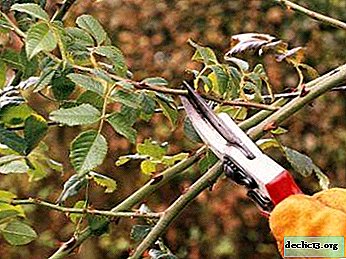 Pruning. Form bushes of any age. In the spring, after removing shelters from the bushes, all frozen, dry and diseased shoots are removed. Annual branches are shortened by 5 buds, old - by 3. In the summer, faded buds, diseased parts of plants are cut. With severe thickening, the bushes thin out, cutting out weak shoots and branches growing inside the bush. This fall, this year's shoots and weakened branches are shortened.
Pruning. Form bushes of any age. In the spring, after removing shelters from the bushes, all frozen, dry and diseased shoots are removed. Annual branches are shortened by 5 buds, old - by 3. In the summer, faded buds, diseased parts of plants are cut. With severe thickening, the bushes thin out, cutting out weak shoots and branches growing inside the bush. This fall, this year's shoots and weakened branches are shortened.- Transfer. The best time for transplanting is early spring and early fall (late August to early September). The technology is similar to planting roses. If the roots are damaged, it is advisable to use root formation stimulants (Kornevin, Heteroauxin), dusting the root system with them.
- Wintering. Roses hibernate in the middle lane under light cover with non-woven material. They withstand short-term light frosts and are more prone to aging. In latitudes with little snow and windy winters, hives require hilling to a height of 2-3 buds. Shelter dates of roses are determined by the date of the last pruning.Before sheltering, the rose garden is cleaned of plant debris, the soil is loosened. For 2 weeks, the treatment for diseases is carried out with a solution of iron sulfate.
Breeding
The best way to propagate bouquet roses is cuttings. The best time to harvest cuttings is from May to August.
- Select thin lower shoots or thin shoots ending in a flower.
- A stalk 15 cm long. Must have 4 kidneys. It is cut from the middle of the stem.
- Slices are made with a sharp secateurs. The lower ones are at an angle of 45 degrees, the upper ones are straight.
- The lower ends of the cuttings are powdered with a root stimulant.
- Planted in boxes filled with a mixture of turf, sheet soil and sand (2: 1: 2) and put in a shaded, cool place.
- It is recommended to cover the boxes with foil to create a greenhouse effect.
- In the morning and evening hours spend sprinkling.
Diseases and Pests
| Title | Description | Control measures |
| Aphid | A small insect of black or green color, settles on the underside of the leaf and buds. It sucks the juices from the plant, which leads to curling of the leaves and falling buds. | Chemical:
Folk:
|
| Spider mite | Very small insect. You can notice it on the web on the leaves and stems and dots on the sheet. Affected leaves turn yellow and crumble. | Use Fitoverm or Vermitek insecticides |
| Powdery mildew | Fungal disease, often manifested in cold rainy weather in the form of a whitish coating on the leaves. | Preventive measures are the treatment of plants with a solution of copper sulfate, or Fitosporin-M. If the disease has begun, Topaz, Skor fungicides are used. |
| Black spotting | It appears in the form of black spots with a yellow fringing and affects leaves and shoots. As a result, the leaves showered green. |
|
Despite these pests and diseases, most varieties have high resistance to them and are affected only in adverse years. For the rest, these are unpretentious and responsive to minimal care roses, which deserve a worthy place in any garden.

 Pruning. Form bushes of any age. In the spring, after removing shelters from the bushes, all frozen, dry and diseased shoots are removed. Annual branches are shortened by 5 buds, old - by 3. In the summer, faded buds, diseased parts of plants are cut. With severe thickening, the bushes thin out, cutting out weak shoots and branches growing inside the bush. This fall, this year's shoots and weakened branches are shortened.
Pruning. Form bushes of any age. In the spring, after removing shelters from the bushes, all frozen, dry and diseased shoots are removed. Annual branches are shortened by 5 buds, old - by 3. In the summer, faded buds, diseased parts of plants are cut. With severe thickening, the bushes thin out, cutting out weak shoots and branches growing inside the bush. This fall, this year's shoots and weakened branches are shortened.






